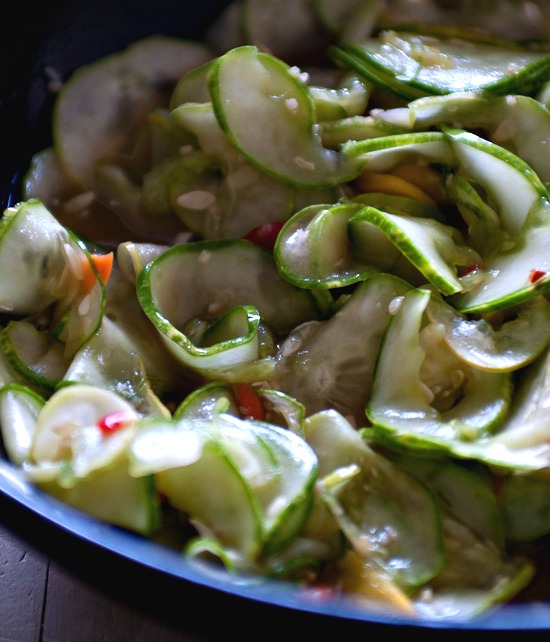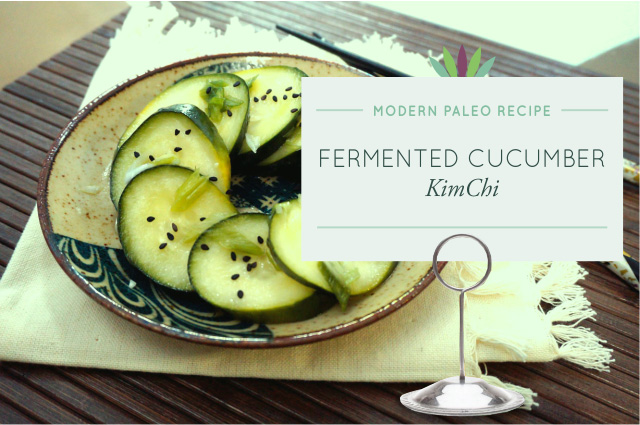My version of Fermented Cucumber Kimchi takes it easy on the spices. I like kimchi, but sometimes the spice and garlic is a bit much. This is a milder version of one of my favorite side dishes.
While slowly fermented cabbage and pungent garlic are the ingredients most people associate with kimchi, there are dozens and dozens of other versions of Korea’s national dish. They feature all manner of vegetables, such as these fermented cucumbers with just a trace of spice and some added black sesame seeds for a splash of decoration (and nutrition).
Making cultured veggies amounts to something you only have to do once every six months. Make enough to last you a long time and gift to frenemies! Store-bought ferments are very expensive and you likely won’t eat enough (to get lots of gut bugs) when you simply make your own for less $$$.
The airtight containers used for fermenting can be glass or stainless steel. Use any size container you like that seals with a rubber or plastic ring and a clamp down lid or mason jars.
During this fermentation period, the friendly bacteria are having a heyday, reproducing and converting sugars into lactic acid. Once the veggies have sat at room temperature for your desired period of time, it is time to slow down the bacterial activity by putting the cultured veggies in the refrigerator. The cold greatly slows the fermentation, but does not stop it completely. Even if the veggies sit in your refrigerator for months, they will not spoil. They become more delicious with time. They will have about an eight month shelf life.
Ingredients
 6-8 medium cucumbers
6-8 medium cucumbers- 4 scallions sliced
- 4 garlic cloves minced
- 1 thumb-sized knob of ginger minced
- 1/8 cup black sesame seeds (you can use regular, too, but they’re not nearly as pretty)
- 1 cabbage leaf per jar of kimchi
- 1 teaspoon cayenne pepper or Korean red pepper
- 1 teaspoon coarse sea salt (table or kosher salt will yield mushier kimchi)
- One package Body Ecology starter culture, whey drippings, or similar
Directions
Step 1
Make your culture. Use whey or similar or Dissolve one or two packages of Body Ecology’s starter culture in 1½ cup warm (90*) water. Add aproximately 1 tsp. of some form of sugar to feed the starter (try Rapadura, Sucanat, honey, or EcoBLOOM). Let starter/sugar mixture sit for about 20 minutes or longer while the L. Plantarum and other bacteria wake up and begin enjoying the sugar. Add this starter culture to the kim chi mixture (step 3).
Step 2
Cut the tips off both ends of the cucumbers and throw away. Thinly slice the cucumbers with a knife or a mandolin (MUCH easier).
Step 3
In another bowl, combine all the other ingredients, including the starter culture or whey. Add the spice paste to the cucumbers and mix together. Set aside any remaining liquid to pour over the cucumbers when they are placed in the jars.
Step 4
Pack the cucumbers tightly in a glass or stainless-steel container. Use your hand, a wooden spoon, or a potato masher to pack veggies tightly. If needed, add some of the kimchi mixture and culture starter liquid if more liquid is needed to cover the veggies. Add a piece of rolled cabbage on the top of your veggies to keep the cucumbers pressed down and under the liquid while they are fermenting. If they are not submerged they can mold.
Step 5
Add the lids to your containers and allow them to rest at room temperature for your desired length of time. Room temperature means 72 degrees Fahrenheit. You can ferment for 8 hours, 3 days or 7 days and anywhere in between. I prefer to let my veggies ferment for at least three days for maximum gut bugs. Some like six or seven days. You can taste them at different stages and decide for yourself. Refrigerate when you are done fermenting.
Troubleshooting your Ferment
Sometimes the beauty of making your own fermented veggies does not go as planned. Mold or brown areas can form. Brown or colorful mold means it has spoiled and it’s time to throw it out.
White layers on your veggies are normal. This is where the piece of cabbage comes in. A white layer can form on it and you can throw it away and eat the fermented veggies underneath. Usually a whitish layer floating on the surface of the ferment is not mold at all, but rather a layer of yeast called kahm yeast. It can develop as the lactic acid bacteria consume all the sugar and the pH of the ferment drops. The easiest thing to do is simply remove the white layer and discard it as soon as you notice it forming. The vegetables below the surface are still fine. The most common reasons for the development of kahm yeast are that the vegetables are not submerged in liquid or the container is not sealed.
The veggies must be under liquid or they can mold, too. If your veggies are molding, you need to check your seal. Rubber rings and a good tight seal keep them from getting moldy. You don’t want to eat moldy veggies.
Don’t be afraid of noise, bubbling, and liquid escaping the lids! It means that your ferment is happening! I usually put my jars in bowls or pans to catch the escaping liquid. If there is liquid in the pans, I know that my culture’s alive! Some recommend burping (uh, opening) the jars once a day to release any gases formed during the ferment. This is one option.
Learn a million more tips for troubleshooting your veggies here.











